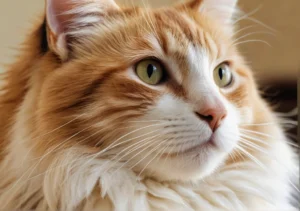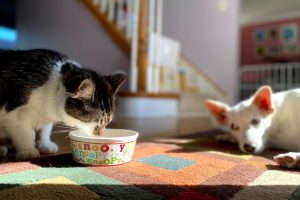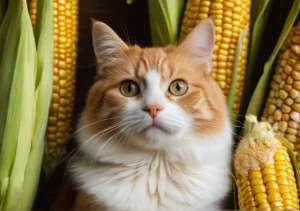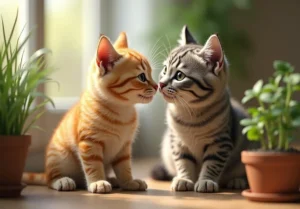Cats are known for their curious eating habits, but have you ever wondered why they sometimes munch on hay? In this blog post, we will explore the reasons behind this strange behavior and uncover the truth about why cats eat hay.
Have you ever caught your feline friend nibbling on some hay and wondered why they do it? Cats eat hay for a variety of reasons, including aiding in digestion and providing essential nutrients. Let’s take a closer look at this fascinating behavior and delve into the reasons behind it.
Natural Instinct
Cats may seem like sophisticated creatures, but at their core, they have primal instincts that drive their behavior. One such instinct is the need to consume grass or in this case, hay. In the wild, cats often eat grass to help with their digestion and to expel any unwanted substances from their stomach. This behavior is thought to stem from their ancestors who would consume the stomach contents of their prey, which often included plants.
Offering your indoor cat access to hay can satisfy this natural instinct and provide them with the fiber they need to regulate their digestive system. It can also help prevent them from nibbling on houseplants, some of which may be toxic to cats. So, if you find your feline friend munching on a pile of hay, rest assured that they are simply following their innate instincts for a healthier gut.
Health Benefits
Apart from fulfilling a natural instinct, hay can also offer several health benefits to your furry companion. By adding hay to their diet, you can help promote healthy digestion and prevent issues like constipation or hairballs. The fibrous nature of hay can aid in moving food through their digestive tract smoothly, preventing any blockages along the way.
Moreover, hay can act as a natural toothbrush for cats. As they chew on the fibrous strands, it helps clean their teeth, reducing plaque build-up and promoting dental health. So, next time you see your cat indulging in a bit of hay, know that they are not just satisfying a craving but also taking care of their well-being in a feline-friendly way.
Additional Insight : In addition to aiding digestion, some types of hay, such as Timothy hay, can also help maintain your cat’s ideal weight by providing a low-calorie, high-fiber snack option. This can be especially beneficial for indoor cats who may not get as much exercise as their outdoor counterparts. So, consider adding a bit of hay to their diet as a healthy and satisfying treat.
Nutritional Value
Hay is not just for horses – it can actually be beneficial for cats too! Fiber found in hay can aid in digestion and prevent hairballs. Additionally, hay provides essential vitamins and minerals such as vitamin A and potassium, which are important for your feline friend’s overall health. So, if you catch your cat nibbling on some hay, don’t be alarmed – they might just be trying to boost their nutrition!
Behavioral Reasons
Have you ever wondered why your cat seems to enjoy munching on hay? Well, it could be due to behavioral reasons. Cats might nibble on hay out of boredom, to help alleviate stress, or even to fulfill their natural instinct to chew on grass. Providing your cat with some hay to nibble on might just be the perfect way to keep them mentally stimulated and happy. So, next time you see your cat enjoying a snack of hay, know that they’re just looking out for their own well-being.
Safe Options
When it comes to choosing hay for your cat, opt for high-quality timothy or orchard grass hay, as these are safe options that provide essential fiber for your feline friend. Avoid alfalfa hay, as it is high in calcium and protein, which can be harmful to cats in large amounts. Look for hay that is free from pesticides, chemicals, or mold, and ensure it is fresh and dry to prevent any digestive issues. Always check the packaging for any additives or preservatives that could be harmful to your cat.
Safe hay options for cats: 1. Timothy hay 2. Orchard grass hay
Monitoring Consumption
Curious why your cat is munching on hay? While it’s normal for cats to eat small amounts of hay to aid in digestion or help with hairballs, excessive consumption can indicate an underlying health issue. Keep an eye on how much hay your cat is eating and monitor for any changes in behavior or appetite. If your cat starts eating large quantities of hay or shows signs of distress such as vomiting or diarrhea, consult your veterinarian immediately for a thorough check-up.
Monitor your cat’s hay consumption:
– Watch for any sudden increase in hay intake
– Look out for changes in behavior or appetite
– Consult your vet if you notice any unusual symptoms
For more information on the dietary habits of cats, you can refer to this resource by the American Society for the Prevention of Cruelty to Animals (ASPCA): ASPCA Cat Nutrition
Introducing Hay
If you’re looking to introduce hay into your cat’s diet, it’s important to do so gradually. Cats are known for being picky eaters, so a sudden change in their diet could lead to digestive issues or rejection of the hay. Start by mixing small amounts of hay with their regular food and slowly increase the hay portion over time. This gradual approach will help your cat adjust to the new food without causing any tummy troubles.
Fun Facts
Did you know that cats often eat hay to help with digestion? Hay is high in fiber, which can aid in regulating their digestive system and preventing hairballs. Another fun fact is that cats may instinctively eat grass or hay to help them expel any indigestible material from their stomachs. So, if you’ve ever caught your kitty nibbling on some hay, it may just be their way of keeping their tummy happy and healthy! Remember, always ensure the hay you provide is fresh and free from any pesticides or chemicals to keep your feline friend safe and content.
Alex, a passionate animal lover, has experience in training and understanding animal behavior. As a proud pet parent to two dogs and three cats, he founded AnimalReport.net to share insights from animal experts and expand his knowledge of the animal kingdom.




